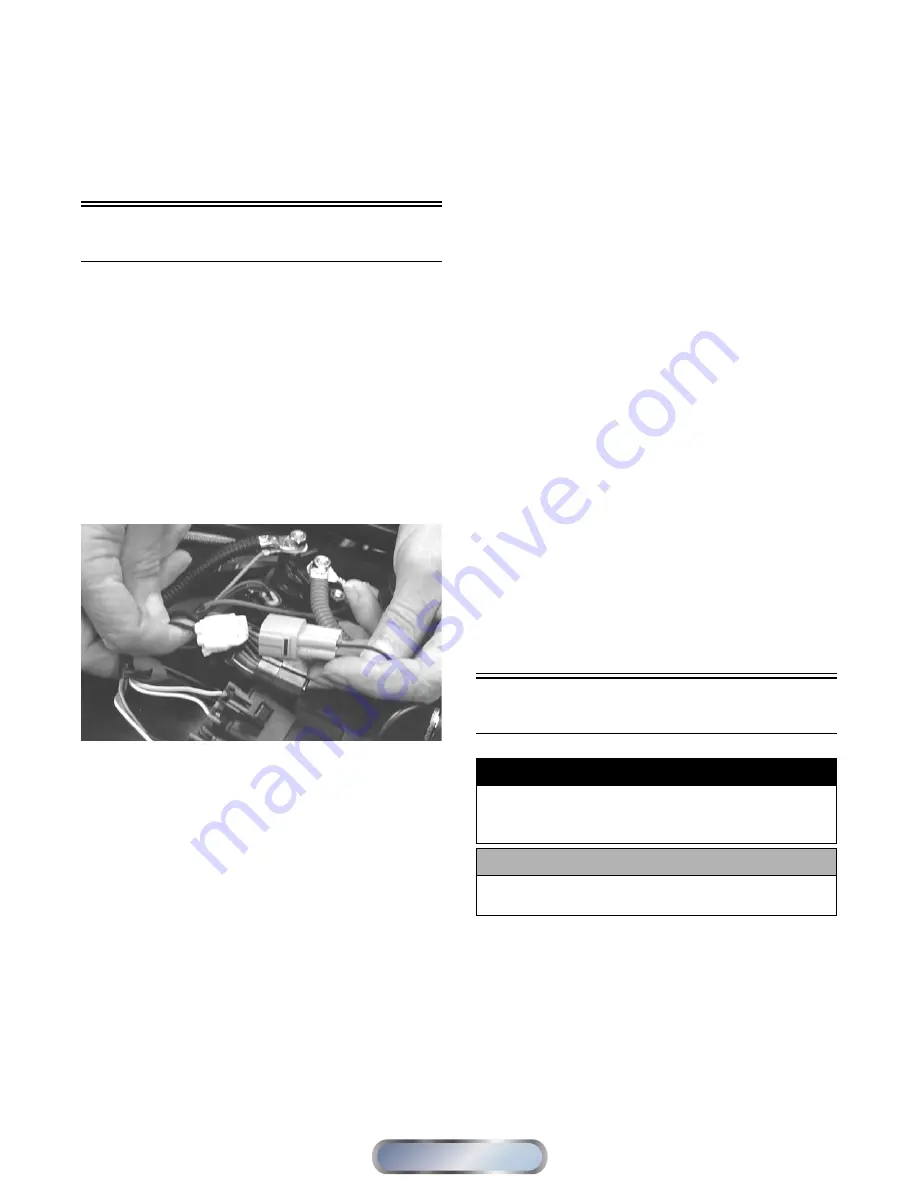
5-14
2. Start the engine and using the RPM function on the
speedometer/tachometer, run at 1500 RPM; ignition
timing should be 10° BTDC.
3. Install the timing inspection plug.
If ignition timing cannot be verified, the rotor may be dam-
aged, the key may be sheared, the trigger coil bracket may
be bent or damaged, or the ECU may be faulty.
ECU Error Codes
If a sensor fails or an out-of-tolerance signal is sensed by
the ECU, an error code will be generated by the ECU.
This will result in the analog needle swinging full scale.
The EFI icon will flash.
To read the error code(s), use the following procedure.
1. Make sure the ignition switch is in the OFF position;
then remove the seats.
2. Locate the diagnostic plug next to the PDM; then
remove the black rubber cap.
3. Connect the Test Plug from Test Plug/Error Code
List to the diagnostic plug.
ATV-112
4. Turn the ignition switch to the ON position and read
the error code on the LCD. Refer to the following ECU
Error Code List to identify the specific problem area.
ECU Error Code List
NOTE: Each of the following numerical codes will
have a two-letter prefix. A prefix of AC (Active
Code) or SC (Stored Code) will be displayed.
Always correct and clear Active Codes before
clearing Stored Codes.
• 00 = No Fault Detected (active code only)
• 12 = CKP (Crankshaft Position) Sensor*
• 13 = APS (Air Pressure Sensor) - H1
• 13 = MAP (Manifold Absolute Pressure) Sensor - H2
• 14 = TPS (Throttle Position Sensor)
• 15 = ECT (Engine Coolant Temperature) Sensor
• 16 = Speed Sensor
• 21 = IAT (Inlet Air Temperature) Sensor
• 23 = Tilt Sensor*
• 24 = Ignition Coil #1*
• 26 = Ignition Coil #2* - H2
• 32 = Fuel Injector #1*
• 34 = Fuel Injector #2* - H2
• 40 = ISC (Idle Speed Control) Valve
• 41 = Fuel Pump Relay*
• 60 = Cooling Fan Relay
• 95 = Sensor Power
• 96 = Incorrect ECU*
• 97 = ECU Memory Power (constant battery power)
• 98 = ECU to Gauge Comm Link - H2
• 99 = Start/Run Not Possible (active code only)
*Will initiate code 99.
After all stored codes are cleared, clear the error code(s)
using the following procedure.
NOTE: The ignition switch should be in the OFF
position.
1. With the test plug connected to the diagnostic plug
and the drive select switch in the 4WD position, hold
the reverse override switch down and turn the igni-
tion switch to the ON position.
2. After ten seconds, release the reverse override switch
and turn the ignition switch to the OFF position; then
turn the ignition switch to the ON position. The dis-
play should read AC00 (no fault detected).
NOTE: If the LCD still displays an error code,
continue troubleshooting the appropriate compo-
nent.
3. Disconnect the test plug; then install the black rubber
cap.
4. Install the seats making sure they lock securely in
place.
Tilt Sensor
SUPPLY VOLTAGE
1. Disconnect the three-wire connector from the sensor;
then select DC Voltage on the multimeter and con-
nect the red tester lead to the orange wire (C) and the
black tester lead to the black wire (A).
! WARNING
Incorrect installation of the tilt sensor could cause
sudden loss of engine power which could result in
loss of vehicle control resulting in injury or death.
CAUTION
Do not drop the tilt sensor as shock can damage the
internal mechanism.
Manual
Table of Contents
















































